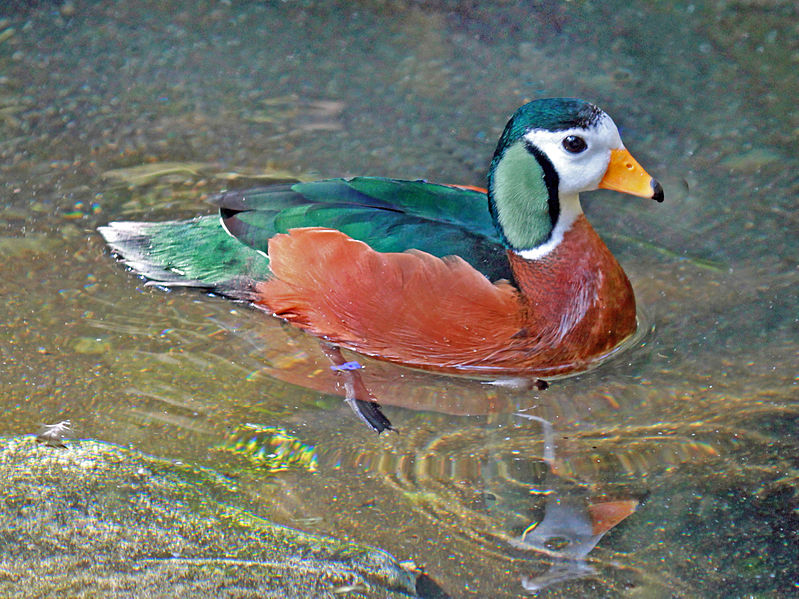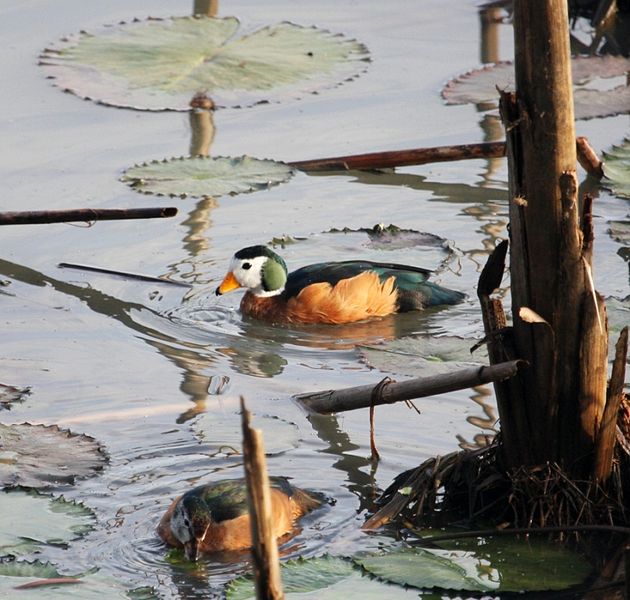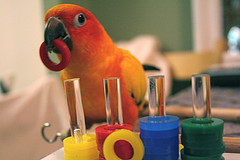 Ducks and geese have many endearing qualities, but few private keepers have the space and flowing water required by most species. Although not common in captivity, the diminutive African Pygmy Goose, Nettapus auritus, is an ideal alternative to its larger relatives. Those I’ve cared for have been delightful, and quite hardy once established. The Indian Pygmy Goose, N. coromandelianus, offers another option; I’ll cover its care in the future.
Ducks and geese have many endearing qualities, but few private keepers have the space and flowing water required by most species. Although not common in captivity, the diminutive African Pygmy Goose, Nettapus auritus, is an ideal alternative to its larger relatives. Those I’ve cared for have been delightful, and quite hardy once established. The Indian Pygmy Goose, N. coromandelianus, offers another option; I’ll cover its care in the future.
Natural History
Averaging 12 inches in length, the African Pygmy Goose is the smallest of the world’s waterfowl. Technically a “perching duck”, its common name is derived from the stubby, goose-like bill. Others which share its un-duck-like habit of nesting in trees include the strikingly-marked Mandarin and Wood Ducks (please see the article below).
African Pygmy Geese are widespread in Sub-Saharan Africa andMadagascar. They reside in swamps, marshes, flooded savannas, sluggish rivers and similar densely-vegetated habitats (please see photo). Shy and secretive, they do not frequent open water, and fly into thick brush when disturbed.
The seeds of water lilies and other aquatic plants appear to be the Pygmy Goose’s primary food, although shoots and leaves are also taken. Those I cared for also relished small insects and shrimp.
African Pygmy Geese typically nest in tree hollows, but seem more flexible in this regard than related species. Nests have also been found in rock cavities, abandoned termite mounds, thatched roofs and within the nests of larger birds. The 6-12 tiny (1” x 1.5”) eggs are incubated for 22-24 days.
Conservation Needs
The outlook for the Pygmy Goose’s survival varies over its wide range. In some regions, dams have created the shallow, weedy waters they prefer, and numbers have increased. In other areas, the introduction of Tilapia, Nile Perch and other non-native fish has changed the local aquatic plant communities; as Pygmy Geese are highly dependant upon specific seeds for food, they abandon degraded habitats. Hunting is said to be a threat inMadagascar.
Captive Care
It wasn’t until the 1930’s that the first pair of African Pygmy Geese arrived inEngland. Their “painted toy” appearance, which still endears them to collectors, quickly aroused the interest of aviculturists. However, traditional waterfowl-keeping techniques did not work well, and it took some time to establish them in captivity. Even today, they are not common in private or public collections.
My first contact with African Pygmy Geese came while working in the Bronx Zoo’s Aquatic Bird House. Off the beaten path and receiving relatively few visitors, the building’s densely-planted exhibits were ideal for shy species and delicate rarities. In fact, many breeding and longevity records were set there…including several sandpipers and plovers that lived into their 30’s. We even housed our rare, skittish Goliath Frogs there for a time, fearing that the Reptile House crowds might be too much for them
Housing
 Our Pygmy Goose Exhibit measured only about 6-8’ square, but it supported a lush growth of semi-aquatic and woodland plants, and was stocked with dead logs, rocks and other cover. Successful private breeders utilize similar designs. Size is not as important as security and cover, although large enclosures are desirable. Wild Pygmy Geese sometimes congregate in flocks outside of the mating season, but captives are usually kept in pairs; in fact, I cannot recall seeing any groups in zoos.
Our Pygmy Goose Exhibit measured only about 6-8’ square, but it supported a lush growth of semi-aquatic and woodland plants, and was stocked with dead logs, rocks and other cover. Successful private breeders utilize similar designs. Size is not as important as security and cover, although large enclosures are desirable. Wild Pygmy Geese sometimes congregate in flocks outside of the mating season, but captives are usually kept in pairs; in fact, I cannot recall seeing any groups in zoos.
As these tiny beauties do not generate the volume of waste for which ducks are so famous, their enclosure need-not be supplied with constantly running water. They feed at and below the water’s surface, and are content with a pool of 8-12 inches in depth. A powerful filter will enable you to cut back on potentially-stressful chores such as draining the pond.
Diet
Commercial waterfowl pellets and small seeds (millet and others typically found in finch mixes) can form the bulk of the diet.
Aquatic plants are greatly appreciated…Duckweed is a particularly important food item, and nearly indispensible when young are being reared. It’s a simple matter to grow Duckweed in an outdoor container exposed to the sun (“too simple”, according to some pond-owners!). Chopped kale, dandelion, romaine, sprouting grass and other greens should also be offered. My Pygmy Geese readily consumed small crickets, mealworms and shrimp, but many keepers do not provide live foods.
Breeding
Captive breeding is regular but not common in the USA (please see article below). Females sometimes utilize Wood Duck nesting boxes, but seem to prefer elevated hollow logs.
The Future
 With proper care, African Pygmy Geese prove to be hardy, long-lived captives that are a pure joy to keep. Due to their small size, it is easy to provide them with a somewhat naturalistic enclosure, and to observe a wide range of interesting behaviors. I hope to see more private keepers work with them in the coming years… lessons learned could well be applicable to their rarer relatives.
With proper care, African Pygmy Geese prove to be hardy, long-lived captives that are a pure joy to keep. Due to their small size, it is easy to provide them with a somewhat naturalistic enclosure, and to observe a wide range of interesting behaviors. I hope to see more private keepers work with them in the coming years… lessons learned could well be applicable to their rarer relatives.
Further Reading
Video: wild African Pygmy Geese
Pygmy Geese and other African waterfowl at Sylvan Heights Bird Park
Keeping Mandarin and Wood Ducks
World Zoo Association Fact Sheet
African Pygmy Goose image referenced from wikipedia and originally posted by DickDaniels
Juvenile African Pygmy Goose image referenced from wikipedia and originally posted by Scott Calleja
 That Bird Blog – Bird Care and History for Pet Birds
That Bird Blog – Bird Care and History for Pet Birds



Thanks for this post! What an interesting bird, and very beautiful too. I love it’s coloration. Very interesting with the green and orange.
Thanks again!
Hello Sandy
Thanks for your interest and the kind words. They really are quite unique – especially since they are so small, by duck standards; they resemble hand-painted toys in a way! Too bad they are not seen so often in private collections or zoos here, photos do not do them justice. I see some nice birds on your site…will take a closer look,
Please let me know if you need any further information. Good luck, enjoy and please keep me posted.
Best regards, Frank Indiviglio.
Frank, are you in the U.S.? I’ve always wanted to try rearing some pymy geese, but it is difficult to find breeding stock. I’m a retired wildlife biologist and have reared wood ducks, mallards, bobwhite quail, and double-yellow headed parrots with much success. I’ve always wanted pygmy geese, but have read that they are very difficult to rear and require heated enclosure in areas that freeze during winter. I’m also aware of the high cost per pair (over $3,000). On a scale of 1-10, with 10 meaning easy, how hard are they to rear?
Hi Larry,
Nice to hear from you. I am in the US (NY). They are quite sensitive to the cold (judging from range and what’s done in zoos; I’ve never tried them outdoors). Hard to rank them , as there are so many variables. Cover, warmth and as little disturbance as possible seem to be critical; diet fairly straightforward. You would certainly have the expertise, but I’m guessing location would be their main drawback?
Please keep me posted..I’m not in touch with any breeders directly, but could cast about if you need. Best, Frank
Best regards, Frank
How cold tolerant are African Pygmy Geese. Can they be outdoors in mild winters in Houston?
Hello Patrick,
Zoos treat them as cold-sensitive; unlike some other tropical waterfowl, they do not adjust well to temperatures much outside those typical of their habitat. They might be able to tolerate the high 50’s (F) if given access to a heated shelter, but it would be risky. I believe Houston’s winters, (while far more pleasant than those here in NY!), would be too cold. Best regards, Frank
Hey Frank,what a nice reading…
I am a bird lover in Miami FL and I got in love with the African pygmy goose 6 years ago when I saw them the first time at Animal Kingdom
What a nice little colorful bird was my first thought.
And they are,I started looking for them and the only Breeder I know was Sylvan Heights I called them and they said I had to be in a list and they would cost $5000 the pair,I said yes ans ask them to be in the list.
Thank God I could get some Pygmies for me for much less of the cost and I’ve been working with them for two years already.
When I saw your post here I was glad that I was doing exactly what you say without know,I can tell you for sure that those little guys do not tolerate cold at all and they will just die in a cold night or get a nostril infection because the cold.
Even here in Miami a heated shelter or a heated pond is necessary for them.
And they just love duckweed.
I am keeping my Pygmies with seed finch mix add red millet because they like it and I will try now some worms because this was the first time I heard they like it.
Thank you very much for all your tips.
Best regards
Robert
Hi Robert,
Thanks for the kind words, much appreciated. Nice to hear you are working with them…they are hard to come by here, and most people do not try as hard as you to locate them.
S. Fla is tricky,…lures one into a false sense of security. Reptile and fish keepers are also sometimes caught by surprise. Please keep me posted, good luck and enjoy, Frank
I thought the Cotton Teal, or Indian Pygmy was the worlds smallest.
Thank you for leaving your comment. Pygmy geese general grow to about the same size, 33 cm or 12 inches max. This blog was only to reference one particular breed. We hope that you enjoyed reading!